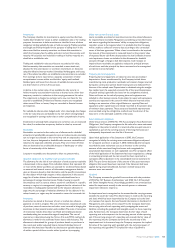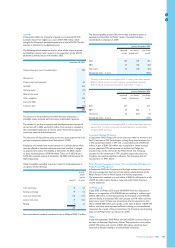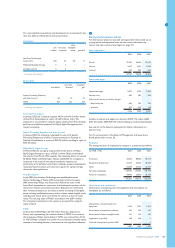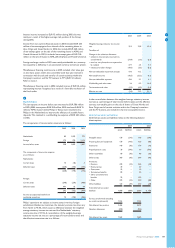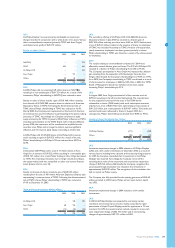Philips 2005 Annual Report Download - page 139
Download and view the complete annual report
Please find page 139 of the 2005 Philips annual report below. You can navigate through the pages in the report by either clicking on the pages listed below, or by using the keyword search tool below to find specific information within the annual report.
Philips Annual Report 2005 139
New accounting standards
The FASB issued several pronouncements, of which the following are
applicable to the Company.
In November 2004, SFAS No. 151, ‘Inventory costs, an amendment of
ARBNo.43,Chapter4’wasissued.ThisStatementclariesthe
accounting for abnormal amounts of idle facility expense and waste and
prohibits such costs from being capitalized in inventory. In addition, this
Statementrequiresthatallocationofxedproductionoverheadstothe
inventory cost be based on the normal capacity of the production
facilities. In accordance with the early adoption provisions of the
Statement, the Company has adopted SFAS No. 151 effective January 1,
2005. This Statement did not have a material effect on the Company’s
nancialstatements.
In December 2004, the FASB issued SFAS No. 153, ‘Exchanges of
Non-monetary Assets’, an amendment of APB Opinion No. 29. This
Statement eliminates the exception in Opinion No. 29 for non-monetary
exchanges of similar productive assets and replaces it with a general
exception for exchanges of non-monetary assets that lack commercial
substance. The Statement will become effective for the Company in
2006 but is not expected to have a material impact.
SFAS No. 123 (revised 2004), concerning share-based payment was
issued in December 2004. The Statement is a revision of SFAS No. 123,
‘Accounting for Stock-Based Compensation’, which was adopted by the
Company in 2003.
SFAS No. 123 (revised 2004) supersedes APB Opinion No. 25 that
allowed the use of the intrinsic value for measuring stock-based
compensation expenses for stock issued to employees. The revised
Statement focuses primarily on accounting for transactions in which an
entity obtains employee services in share-based payment transactions.
The revised Statement contains certain changes compared with the
original pronouncement. The most relevant for the Company will be the
requirement to estimate forfeitures.
The Company will adopt SFAS No. 123 (Revised 2004) effective January
2006,usingthemodiedprospectivemethodforthetransition.Since
the Company has previously adopted the fair value recognition provisions
of SFAS No. 123, the effects of the adoption revised standard on the
Company will not be material and will be primarily limited to the effects
on compensation expense for the difference, if any, between estimated
forfeitures under SFAS No. 123(R) and actual forfeitures under
SFAS No. 123.
In March 2005, FASB Interpretation No. 47 ‘Accounting for Conditional
AssetRetirementObligations’wasissued.TheStatementclariesthat
the obligation to perform the asset retirement activity is unconditional
even though uncertainty exists about the timing and the method of
settlement. Accordingly the Company would be required to recognize a
liability for the fair value of a conditional asset retirement obligation if
that fair value can be reasonably estimated. The Company has investigated
the existence of such obligations and concluded that the effects on the
nancialstatementsarenegligible.TheStatementbecameeffectiveon
December 31, 2005.
In May 2005 the FASB issued SFAS No. 154 ‘Accounting Changes and
Error Corrections’, which replaces APB Opinion No. 20 and SFAS No. 3.
The Statement establishes retrospective application as the required
method for reporting a change in accounting principle in the absence of
explicit transition requirements for new accounting pronouncements.
Error corrections must be applied in the same way as accounting changes.
In conformity with the transition guidance in this Statement, the Company
adopted SFAS No. 154 as from May 2005.
In June 2005, the FASB issued FASB Staff Position No. 143 ‘Accounting
for Electronic Equipment Waste Obligations’. This Staff Position concerns
the recognition of liabilities resulting from the European Union’s
Directive on Waste Electrical and Electronic Equipment (WEEE),
which came into effect on February 13, 2003. Member States were
required to transform the Directive into national law by August 13, 2004.
The Directive stipulates who is reponsible for the costs related to the
environmentally sound disposal of waste of certain types of goods.
The Staff Position is primarily related to historical waste arising from
sales before the enactment dates of the local laws and has mandated
that no liability shall arise for historical waste held by private
households, other than for waste costs for equipment in the measurement
period. For products sold to commercial users, the guidance under
SFAS No. 143 ‘Asset Retirement Obligations’ is applied, which had no
materialeffectontheCompany’snancialstatements.
The Company is a provider of equipment that falls under the EU Directive,
particularly in the segments Lighting, Consumer Electronics, Domestic
Appliances and Personal Care, and Medical Systems. As at the end of
2005,severalsignicantEUMemberStateshadnotyetenactedtheir
national legislation. Accordingly, we were not able to reliably estimate all
effects of the WEEE Directive. In as far as the historical waste
is concerned,
which is covered by the Staff Position, the Company concluded
that for the
Member States where the Directive was enacted, the effects on the
income statement are not material as at the end of 2005.
In November 2005, the FASB issued FASB Staff Position No. 45-3
‘Application of FASB Interpretation No. 45 to Minimum Revenue
Guarantees Granted to a Business or Its Owners’. This Staff Position
amends Interpretation 45 and requires the Company to recognize a
liability for guarantees granted to a third party that the revenue for a
speciedperiodoftimewillbeatleastaspeciedamount.TheStaff
Position becomes effective for the Company on January 1, 2006 for
guarantees made since that date. The Staff Position further requires
the Company to make all disclosures required under FIN45 for all
minimum revenue guarantees irrespective of whether or not these
were recognized under FIN45.








